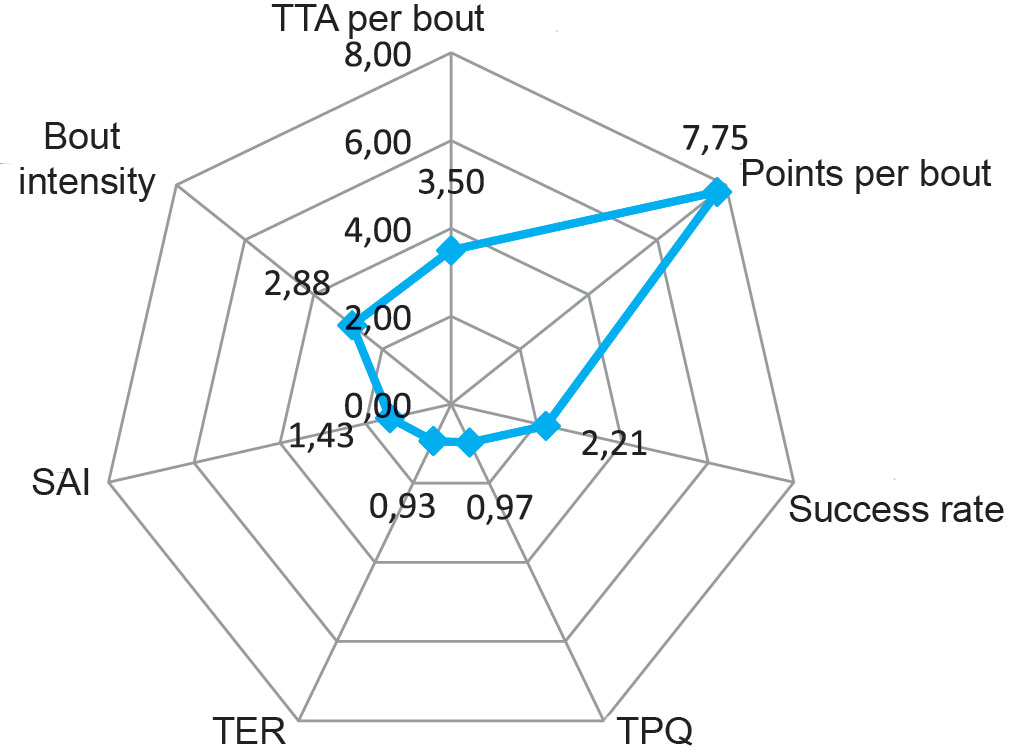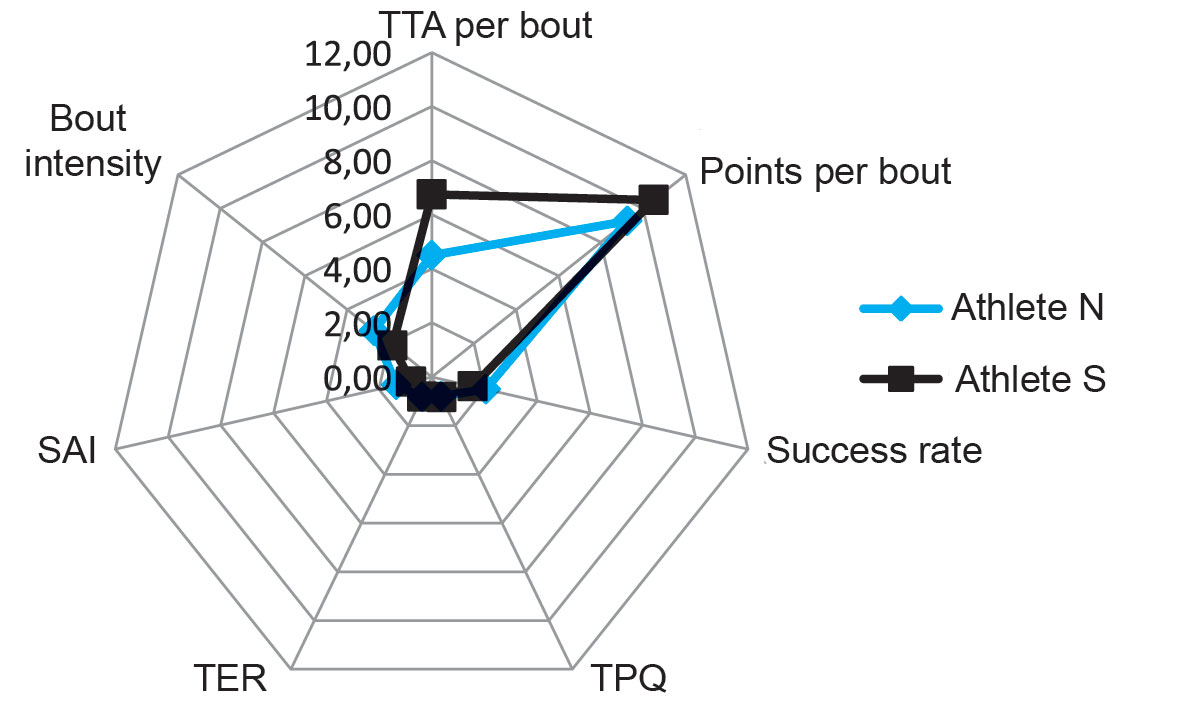Academic wrestlers' age-specific technical and tactical progress control
Фотографии:
ˑ:
PhD E.A. Bavykin2
N.A. Zinoviev2
PhD, Associate Professor S.A. Sidorenko1
1Saint-Petersburg Mining University, St. Petersburg
2D.F. Ustinov "VOENMEKh" Baltic State Technical University, St. Petersburg
Keywords: freestyle wrestling, technique, tactics, competitive performance profile.
Background. Modern academic sports may be described as a specific academic activity including competitive process and precompetitive trainings for success in vocational sports.
In the academic education period of 4-6 years, a young athlete may excel his individual physical qualities and skills in the vocational sport with no detriment to the academic learning process. It should also be noted that modern educational technology is interpreted as a part of educational system geared to secure success based on creative potential, human, material and financial resource of an individual being fully mobilized with the highest efficiency [1, 2]. However, high competitive accomplishments in the academic sports cannot be achieved unless the individual technical and tactical progress is secured and optimized. Our analysis of the competitive performance profiles of the leading adolescent and junior wrestlers made it possible to find the age-specific technical, tactical and competitive progress scenarios.
Objective of the study was to apply a comparative analysis of the competitive performance profiles of the adolescent and junior wrestlers who competed in the 2017 Junior World Freestyle Wrestling Championship and find the age-specific technical, tactical and competitive progress scenarios.
Methods and structure of the study. The authors made a comparative analysis of the competitive performance profiles of the junior winners of the 2017 Junior World Freestyle Wrestling Championship.
The wrestlers’ competitive technical and tactical actions (TTA) were rated using the following rating criteria: scoring TTA; points scored; points lost; scoring attacking TTA; scoring counterattacking TTA; scoring opponent’s attacks; countered attacks; and scoring attacks intervals (SAI).
The individual competitive performance profiles were computed using the following formulae:
- Success rate that is the ratio of the points scores to the total effective TTA.
- Technical performance quality (TPQ) that is the ratio of the total points scored to the total points lost.
- Technical excellence ratio (TAR) that is the ratio of the total effective TTA to the total lost and won TTA.
- Scoring attacks interval (SAI) that is the average time between the scoring TTA.
- Bout intensity that is the total scored points to the total time of the bouts.
- Average effective TTA per bout.
- Average points scored per bout.
Study results and discussion. Our comparative analysis of the competitive performance profiles of the junior winners of the 2017 Junior World Freestyle Wrestling Championship shows the winners to be highly active with the high TTA averages and total scored points per bout: see Table 1 hereunder.
Table 1. Competitive performance rates of the junior winners of the 2017 Junior World Freestyle Wrestling Championship
|
Performance rate |
Value |
|
TTA per bout |
4,96±1,42 |
|
Points per bout |
9,44±1,95 |
|
Success rate, points |
1,94±0,2 |
|
TPQ |
0,83±0,1 |
|
TER |
0,79±0,1 |
|
SAI, min |
0,67±0,36 |
|
Bout intensity |
2,16±0,6 |
It should be noted that adolescent wrestlers were highly active albeit prone to the risky and reckless fight control styles and, as a result, showing low dependability in offence and defence. For example, athlete B, winner in the 85kg weight category, showed high technical excellence ratio and technical performance quality, high TTA per bout and points per bout: see Figure 1. Note that the success rate is still fairly moderate. In the final bout athlete B scored no successful TTA in fact and won only due to a single last effective action. On his way to the finals, however, he won three bouts due to the expressed technical superiority that may be indicative both of his high mastery and low competition from the opponents. That is why he was so reluctant to take effective efforts in the bout with the strong opponent.

Figure 1. Athlete B: individual performance profile
When comparing the competitive performance and technical mastery rates of the adolescent and junior athletes, we should note that the TTA effectiveness depends on the quality of offence and defence. The junior world champions, for instance, demonstrate high technical performance, success and bout intensity rates, with the dependability of their attacks ranked high than that for the adolescent athletes: see Table 2.
Table 2. Competitive performance rates of the junior world champions
|
Performance rate |
Value |
|
TTA per bout |
4±0,71 |
|
Points per bout |
8,5±1 |
|
Success rate, points |
2,13±0,11 |
|
TPQ |
0,89±0,12 |
|
TER |
0,88±0,1 |
|
SAI, min |
1,39±0,1 |
|
Bout intensity |
2,81±0,11 |
To further substantiate the findings, we have compared the individual performance profiles of [senior] athlete S, world champion in the 97-kg category, with athlete N, junior world champion.

Figure 2. Comparative analysis of the individual performance profiles of athletes S and B
Clockwise: TTA per bout, Points per bout, Success rate, TPQ, TER, SAI, Bout intensity
The diagram shows the difference in the average TTA and points per bout in favour of the [senior] champion who showed high dependability in offence, defence and counterattacks. The higher average scoring points per bout are indicative of the high difficulty level and scoring power of his technical actions.
Conclusion
- The adolescent wrestlers’ bouts are faster versus the junior bouts, with higher percentages of the fall wins and clear-advantage wins that are attributable to more deficiencies in the physical and tactical fitness levels of the athletes;
- As far as the wrestlers’ activity is concerned, the adolescent wrestlers are highly active that may be interpreted as their proneness to risky and reckless fight control styles;
- The junior athletes show the higher technical performance, TTA dependability and difficulty levels versus the adolescents;
- The differences found by the study in the TTA rates of the junior athletes versus the adolescent ones may provide a sound basis for the training system design in the academic education and training process.
References
- Ashkinazi S.M., Bavykin E.A. Sovershenstvovanie sistemyspetsialnoy fizicheskoy podgotovki v smeshannykh (kompleksnykh) edinoborstvakh [Improvement of system of special physical training of athletes of complex (mixed) martial arts]. Teoriya i praktika fiz. kultury, 2014, no. 6, pp. 94-98.
- Grakhov V.P., Kislyakova Yu.G., Simakova U.F. Formirovanie i razvitie tvorcheskogo potentsiala lichnosti studentov tekhnicheskikh vuzov [Formation and development of creative potential in technical university students]. Zapiski Gornogo instituta, 2015, pp. 110-115.
Corresponding author: evgeny.bavykin@gmail.com
Abstract
The study makes a comparative analysis of the competitive performance profiles of the junior wrestlers who competed in the 2017 World Freestyle Wrestling Championship. The study data and analysis made it possible to profile the individual competitive performances of the junior wrestlers versus their age-specific competitive technical and tactical progress data. The wrestlers’ competitive technical and tactical actions (TTA) were rated using the following rating criteria: scoring TTA; points scored; points lost; scoring attacking TTA; scoring counterattacking TTA; scoring opponent’s attacks; countered attacks; and scoring attacks intervals (SAI).
The study found the adolescent wrestlers’ bouts being faster versus the junior bouts, with higher percentages of the fall wins and clear-advantage wins that are attributable to more deficiencies in the physical fitness and tactical skill levels of the athletes. As far as the wrestlers’ activity is concerned, the adolescent wrestlers are highly active that may be interpreted as their proneness to risky and reckless fight control styles. The study findings may be applied as a sound basis for the academic wrestlers’ training system designs and plans.




